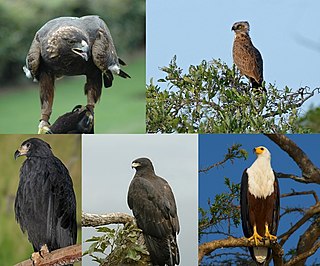
Eagle is the common name for the golden eagle, bald eagle, and other birds of prey in the family of the Accipitridae. Eagles belong to several groups of genera, some of which are closely related. True eagles comprise the genus Aquila. Most of the 68 species of eagles are from Eurasia and Africa. Outside this area, just 14 species can be found—two in North America, nine in Central and South America, and three in Australia.

Mahogany is a straight-grained, reddish-brown timber of three tropical hardwood species of the genus Swietenia, indigenous to the Americas and part of the pantropical chinaberry family, Meliaceae. Mahogany is used commercially for a wide variety of goods, due to its coloring and durable nature. It is naturally found within the Americas, but has also been imported to plantations across Asia and Oceania. The mahogany trade may have begun as early as the 16th century and flourished in the 17th and 18th centuries. In certain countries, mahogany is considered an invasive species.

The lagomorphs are the members of the taxonomic order Lagomorpha, of which there are two living families: the Leporidae and the Ochotonidae (pikas). There are 110 recent species of lagomorph of which 109 are extant, including 10 genera of rabbits, 1 genus of hare and 1 genus of pika. The name of the order is derived from the Ancient Greek lagos + morphē.

Cynognathus is an extinct genus of large-bodied cynodontian therapsids that lived in the Middle Triassic. It is known from a single species, Cynognathus crateronotus. Cynognathus was a predator closely related to mammals and had a southern hemispheric distribution. Fossils have so far been recovered from South Africa, Argentina, Antarctica, and Namibia.

The velvet scoter is a large sea duck, which breeds over the far north of Europe and the Palearctic west of the Yenisey basin. The genus name is derived from Ancient Greek melas "black" and netta "duck". The species name is from the Latin fuscus "dusky brown".
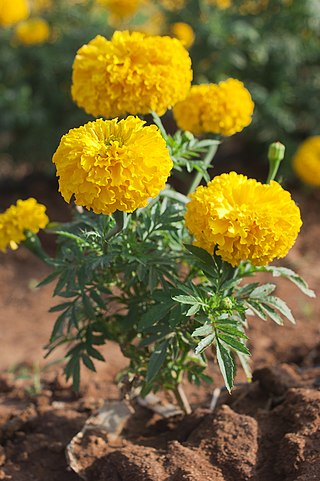
Tagetes is a genus of 50 species of annual or perennial, mostly herbaceous plants in the family Asteraceae. They are among several groups of plants known in English as marigolds. The genus Tagetes was described by Carl Linnaeus in 1753.

Cortaderia is a genus of plants in the Poaceae or grass family of plants.
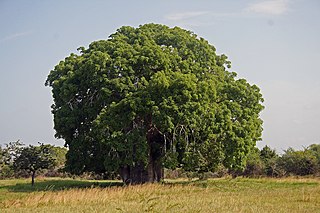
Adansonia is a genus made up of eight species of medium-to-large deciduous trees known as baobabs or adansonias. They are placed in the Malvaceae family, subfamily Bombacoideae. They are native to Madagascar, mainland Africa, and Australia. The trees have also been introduced to other regions such as Asia. A genomic and ecological analysis has suggested that the genus is Madagascan in origin.

Hoodia is a genus of flowering plants in the family Apocynaceae, under the subfamily Asclepiadoideae, native to Southern Africa.
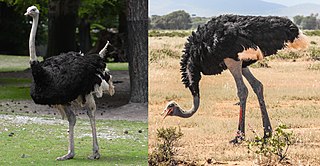
Ostriches are large flightless birds. Two living species are recognised, the common ostrich, native to large areas of sub-Saharan Africa, and the Somali ostrich, native to the Horn of Africa.

Eugenia is a genus of flowering plants in the myrtle family Myrtaceae. It has a worldwide, although highly uneven, distribution in tropical and subtropical regions. The bulk of the approximately 1,100 species occur in the New World tropics, especially in the eastern Brazil's northern Andes, the Caribbean, and the Atlantic Forest. Other centers of diversity include New Caledonia and Madagascar. Many species in the Old World have received a new classification into the genus Syzygium.

Ravenala is a genus of monocotyledonous flowering plants. Classically, the genus was considered to include a single species, Ravenala madagascariensis from Madagascar.

The suni is a small antelope of the family Bovidae, and one of the smallest ungulates on earth. It occurs in dense underbrush from central Kenya to KwaZulu-Natal in South Africa. It is also found on the island of Zanzibar off of Tanzania.

Nuttalliella is genus of tick. It contains a single living species, Nuttalliella namaqua found in southern Africa, having been reported from Tanzania, Namibia and South Africa. The genus is placed in its own family, Nuttalliellidae. It can be distinguished from ixodid ticks and argasid ticks by a combination of characteristics including the position of the stigmata, lack of setae, strongly corrugated integument, and form of the fenestrated plates. It is the most basal lineage of living ticks.

Lanaria is a monotypic genus of flowering plants containing a single species, Lanaria lanata, endemic to the southern coast of South Africa where it is associated with the fynbos belt. Lanaria lanata is commonly known as Cape edelweiss or lambtails. The genus is placed in the monotypic family Lanariaceae, a family only recently recognized by taxonomists. The APG IV system of 2016 does recognize this family.

Diplocercides is an extinct genus of marine coelacanth which lived during the Late Devonian period. It is the only confirmed member of the family Diplocercididae (=Diplocercidae), although some studies classify other genera such as Nesides, Chagrinia, and Euporosteus in it as well.

Cratognathus is a genus in the ground beetle family Carabidae. There are about five described species in Cratognathus, found in Africa.
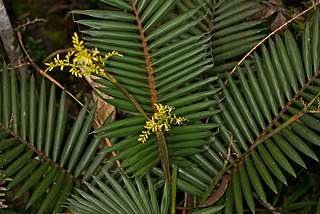
Calamoideae is a subfamily of flowering plant in the palm family found throughout Central America, South America, Africa, India, China, Southeast Asia and Australia. It is represented by 21 genera - containing nearly a quarter of all species in the palm family - including the largest genus, Calamus, the type genus of the group. Only four are found in the New World while the rest are Old World denizens, usually found in equatorial swampland or along tropical coastlines.

The Solanaceae, or the nightshades, is a family of flowering plants that ranges from annual and perennial herbs to vines, lianas, epiphytes, shrubs, and trees, and includes a number of agricultural crops, medicinal plants, spices, weeds, and ornamentals. Many members of the family contain potent alkaloids, and some are highly toxic, but many—including tomatoes, potatoes, eggplant, bell, and chili peppers—are used as food. The family belongs to the order Solanales, in the asterid group and class Magnoliopsida (dicotyledons). The Solanaceae consists of about 98 genera and some 2,700 species, with a great diversity of habitats, morphology and ecology.

Hexophthalma is a genus of spiders in the family Sicariidae. Although the genus was originally erected in 1878, it was merged into the genus Sicarius in the 1890s, and remained unused until revived in 2017, when it was discovered that the African species then placed in Sicarius were distinct. The English name six-eyed sand spiders is used for members of the genus, particularly Hexophthalma hahni.



















